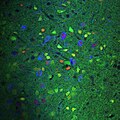Glutamate decarboxylase
Glutamate decarboxylase (GAD) is an enzyme that catalyzes the decarboxylation of glutamate to gamma-aminobutyric acid (GABA) and carbon dioxide. GAD plays a crucial role in the metabolism of amino acids and is pivotal in the process of inhibitory neurotransmission in the central nervous system (CNS). There are two forms of this enzyme, GAD65 and GAD67, named after their molecular weights. These enzymes are encoded by two different genes, GAD1 (GAD67) and GAD2 (GAD65), in humans.
Function[edit]
Glutamate decarboxylase is essential for the synthesis of GABA, the principal inhibitory neurotransmitter in the brain. By converting glutamate, the main excitatory neurotransmitter, into GABA, GAD helps maintain the balance between excitation and inhibition in the CNS. This balance is crucial for normal brain function, and disruptions can lead to various neurological and psychiatric disorders.
Structure[edit]
GAD exists in two isoforms, GAD65 and GAD67, which are encoded by separate genes. These isoforms differ in their distribution, regulation, and function within the brain. GAD67 is ubiquitously expressed in GABAergic neurons and is responsible for the basal levels of GABA synthesis necessary for cell maintenance and non-synaptic GABA signaling. In contrast, GAD65 is mainly involved in synthesizing GABA for neurotransmission and is dynamically regulated by synaptic activity.
Clinical Significance[edit]
- Autoimmune Disorders
Autoantibodies to GAD are a characteristic feature of some autoimmune diseases, including Type 1 diabetes and Stiff person syndrome. In Type 1 diabetes, GAD65 autoantibodies are often present and can serve as a marker for the disease. In Stiff person syndrome, antibodies against GAD65 are thought to impair GABA synthesis, leading to muscle stiffness and spasms.
- Neurological Disorders
Alterations in GAD activity and GABA synthesis have been implicated in several neurological disorders, such as epilepsy, schizophrenia, and major depressive disorder. These conditions may arise from an imbalance between excitatory and inhibitory neurotransmission in the brain.
Genetics[edit]
The human genes GAD1 and GAD2 encode the GAD67 and GAD65 enzymes, respectively. Variations in these genes can affect the function and regulation of GAD, potentially leading to altered GABAergic signaling and susceptibility to neurological and psychiatric disorders.
Pharmacology[edit]
GAD and its product, GABA, are targets for several pharmacological agents. Drugs that increase GABA levels in the brain, such as GABA analogs and GABA reuptake inhibitors, are used to treat conditions like epilepsy and anxiety disorders. Understanding the role of GAD in GABA synthesis has been crucial for developing these therapeutic strategies.
See Also[edit]
-
Structure of GAD67
-
Active site of GAD67
-
pH-induced conformational changes
-
Mouse GAD65 and GAD67
-
Stiff man syndrome in human cerebellum
Ad. Transform your life with W8MD's Budget GLP-1 injections from $75


W8MD offers a medical weight loss program to lose weight in Philadelphia. Our physician-supervised medical weight loss provides:
- Weight loss injections in NYC (generic and brand names):
- Zepbound / Mounjaro, Wegovy / Ozempic, Saxenda
- Most insurances accepted or discounted self-pay rates. We will obtain insurance prior authorizations if needed.
- Generic GLP1 weight loss injections from $75 for the starting dose.
- Also offer prescription weight loss medications including Phentermine, Qsymia, Diethylpropion, Contrave etc.
NYC weight loss doctor appointmentsNYC weight loss doctor appointments
Start your NYC weight loss journey today at our NYC medical weight loss and Philadelphia medical weight loss clinics.
- Call 718-946-5500 to lose weight in NYC or for medical weight loss in Philadelphia 215-676-2334.
- Tags:NYC medical weight loss, Philadelphia lose weight Zepbound NYC, Budget GLP1 weight loss injections, Wegovy Philadelphia, Wegovy NYC, Philadelphia medical weight loss, Brookly weight loss and Wegovy NYC
|
WikiMD's Wellness Encyclopedia |
| Let Food Be Thy Medicine Medicine Thy Food - Hippocrates |
Medical Disclaimer: WikiMD is not a substitute for professional medical advice. The information on WikiMD is provided as an information resource only, may be incorrect, outdated or misleading, and is not to be used or relied on for any diagnostic or treatment purposes. Please consult your health care provider before making any healthcare decisions or for guidance about a specific medical condition. WikiMD expressly disclaims responsibility, and shall have no liability, for any damages, loss, injury, or liability whatsoever suffered as a result of your reliance on the information contained in this site. By visiting this site you agree to the foregoing terms and conditions, which may from time to time be changed or supplemented by WikiMD. If you do not agree to the foregoing terms and conditions, you should not enter or use this site. See full disclaimer.
Credits:Most images are courtesy of Wikimedia commons, and templates, categories Wikipedia, licensed under CC BY SA or similar.
Translate this page: - East Asian
中文,
日本,
한국어,
South Asian
हिन्दी,
தமிழ்,
తెలుగు,
Urdu,
ಕನ್ನಡ,
Southeast Asian
Indonesian,
Vietnamese,
Thai,
မြန်မာဘာသာ,
বাংলা
European
español,
Deutsch,
français,
Greek,
português do Brasil,
polski,
română,
русский,
Nederlands,
norsk,
svenska,
suomi,
Italian
Middle Eastern & African
عربى,
Turkish,
Persian,
Hebrew,
Afrikaans,
isiZulu,
Kiswahili,
Other
Bulgarian,
Hungarian,
Czech,
Swedish,
മലയാളം,
मराठी,
ਪੰਜਾਬੀ,
ગુજરાતી,
Portuguese,
Ukrainian




